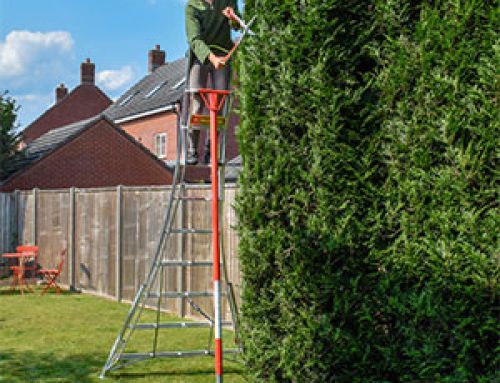In one of our earlier blogs, we had a brief look at the history behind Ladders and their uses over time. Today we associate ladders with changing a light bulb or building works, but back in the Middle Ages a ladder could be the difference between life and death! A siege ladder was a special type of ladder used with a siege tower to help win wars! Who would have thought that such a simple household item could have such a gory past?
Escalade, Scaling and Siege Ladders
Siege ladders were used in many cultures to scale or climb over defensive works such as ramparts and walls. This process was known as 'escalade' which comes from the Italian word 'scalare' which means 'to climb'. This type of warfare continued for hundreds of years, and was often used in the Middle Ages. Employing siege towers and ladders was popular with attackers because they're very easy to construct and use. However, it wasn't all as simple as it sounds there were great dangers in using the siege ladder. Here's how it worked: When a walled fortress or fortification was under attack, the attackers simply approached the base of the wall and extended their ladders to climb it and engage those who were defending the building at the top. The use of scaling ladders shouldn't be thought of as a primary means of attack, though. The idea was to try and get one of your men over the wall and inside the fortifications, so that he could open the gates to let a larger force in.
Tactics for Repelling Scaling and Siege Ladders
The attackers who were using scaling and siege ladders were almost always heavily outnumbered by the defenders at the top of the walls who took measures to repel them, such as hurling boiling liquids (quite often oil) and firing flaming arrows against them. In addition, castles and other fortifications were often designed to resist escalade attacks and to make it as difficult as possible for opponents to extend their ladders. A well known example of this is a moat around a castle stopping attackers from reaching the base of the outer walls with their ladders and siege towers. Taluses were added to walls. A Talus is basically extra bricks round the bottom of a wall, making the wall slope so that again, ladders couldn't get decent grip on the ground or be leant properly against a wall. Machicolations were included too – these were holes through which stones could be hurled down on the attackers. Given that the word 'Machicolation' is derived from the old French words for crush and neck, I think we can assume this was quite a successful form of defense and very often the attackers paid a high price in casualties. To have a chance at being victorious, the attackers had to come in fast with many ladders: Slow deployment gave a significant advantage to the defenders, who could take better aim on the attackers as they climbed and if there were not enough ladders, it meant that not enough attackers would reach the battlements and the chance one of their soldiers would be able to slip though and open the main gates was greatly reduced.
So What Were the Advantages of Scaling Ladders?
Escalade was a popular option in warfare because it allowed attackers to avoid a long and protracted siege. This is especially true if time was important to the attackers, i.e., that they wanted a quick resolution to the conflict. An invading force would also chose escalade over a siege if there were more of them than the defenders. If financial considerations were an issue, a siege usually was preferred. Over time, the siege ladder was developed into a moveable and articulated item that's most likely the oldest type of offensive siege tactics. Siege ladders also were popular with attackers because they offered a much better alternative to physically breaching the defenders' walls.
Features of Scaling Ladders
Some types of scaling ladders were fitted with hooks at the bottom that allow them to dig into the ground, giving a more stable deployment. Other versions had hooks at the top to attach to a roof or rampart very similar to a modern day roof ladder, although people tend to use those to fix tiles or clean gutters and not to attack their castle dwelling neighbours! It was crucial to build a ladder of the right height, because an overly tall one allowed the defenders to push it away with ease. A ladder that wasn't tall enough would prevent anyone from reaching the top of a wall. It's for this reason attackers didn't carry ladders with them when travelling to a site they intended to subject to a siege. Instead, they waited until the target was in sight because then more accurate measurements could then be taken. Scaling ladders were most often used in conjunction with siege towers.
Where There's a Ladder – There's a Tower!
Siege towers were designed and built to protect the attacking forces, and also were capable of holding both weapons and soldiers. They were generally rectangular in shape with wheels underneath to allow the structure to be moved. Towers had a number of internal levels that were accessed by ladders. Near the top was a drawbridge that enabled the attackers to cross over to the defenders' battlements. A protective covering encased a siege tower to repel missiles hurled by the defenders. To create it, animal hides were soaked in a combination of vinegar and mud, which added extra protection. Deluxe model siege towers featured expensive iron plates.
Siege Weapon Construction Methods and Techniques
As expected, being in the business of building expensive siege ladders and towers was extremely lucrative, since these items always were in high demand. A siege was not generally a spontaneous event — it had to be carefully planned and executed by both the military and by specialists and expert artisans. These people first surveyed the site or structure they planned to attack, and then custom-designed siege weapons to be built for that particular location. The project generally required a large number of blacksmiths and carpenters and even the soldiers were expected to help. Material and supplies were gleaned from the countryside, whether the population approved or not!
Britain's Longest Siege
In 1265, after a rebellion led by Simon de Montfort against Henry III in which de Montford died, his followers fled back to Kenilworth Castle, Warwickshire. Henry III followed and began a 6 month siege. The siege tower used could hold about 200 archers and was fitted with 11 catapults. After a protracted struggle, the defenders, weakened by hunger and disease, agreed to a mutual truce. The settlement terms are particularly interesting. Although the rebels were able to buy back the lands they lost, ten counties had their tax payments suspended for 2 years, so they could recover financially. The fact that the terms were so lenient was testament to how well Kenilworth had been designed to repel Siege attacks.
So remember next time you reach for your humble household ladder, what a long and gory history stands behind it!






Leave A Comment
You must be logged in to post a comment.